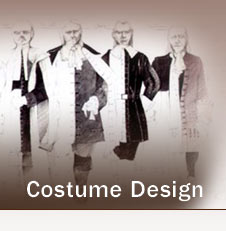What we wear and how we wear it says a lot about how we see ourselves and want others to see us. Clothes worn by actors in performance can speak interestingly about the characters they play and the time in which they are living. Clothes can suggest social class, the membership of social groups – like Townies, Goths or Crusties;they can suggest status, age, sex; and can also work as
visual metaphors displaying outwardly an inner state of being. Think of Shakespeare’s King Lear who starts the play dressed as a King, progresses through nakedness, to end it wrapped in a simple cloth, like a baby or a corpse dressed for the grave.
There is a terrific moment in the performance of
The Crucible when, as John Proctor enters the attic bedroom in Act 1, Abigail smartly takes off her white cap, releasing her long hair in the process, a simple but effective flirtatious gesture emphasised by the costume. Simon speaks of
wanting costumes that look lived in, because in this community not only could individuals not afford new clothes, but also any sign of vanity or outward display would immediately be frowned on. The long black coats of the judges emphasise their stern authority, and, if the audience looked carefully, they would see that Abigail’s neckline was just slightly lower than that of the other Salem girls – her way of using costume as her gesture of rebellion against that authority.
Costumes worn by actors have to be practical, able to stand up to the rigours of being worn sometimes hundreds of times, under hot lighting, in actions that can involve physical exertion and therefore call for flexibility as well as comfort. Simon Higlett says that when he
designs a costume, he
encourages the actor's input and tries to incorporate what he/she wants to do with the part. Costumes for
The Crucible also involve
wigs, and Simon works with the director as well as the Head of Wigs at Birmingham Rep to come up with an effective design.

